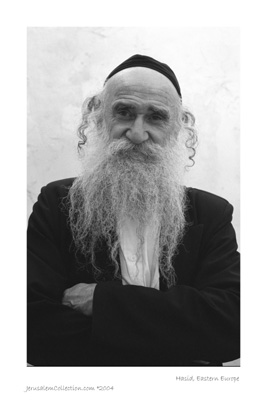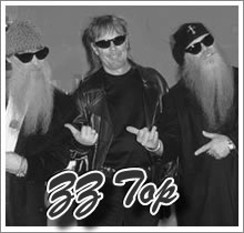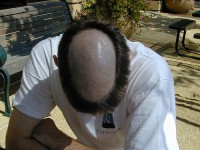

HAIR ON THE HEAD AND BEARD

This is a brief glance at the topic of hair found in the Scripture of Truth.
It is mentioned enough to make us pause and reflect on it, and it seems that there can be a wide variety of ways to wear it, as there are many types of hair. When you look at the many places where hair is discussed in Scripture, and consider them all together, the extremes that many people have imposed on themselves or others are without Scriptural basis. We find ourselves in a dilemma with others when we pluck out one isolated text and allow it to become our example to live by, or we try to impose our impressions and opinions on others.
It's generally agreed that women have a long-standing custom of growing their hair somewhat longer than the average man - but we see that men, at times, had exceptionally long hair as well. Cutting or trimming hair to suit a person's personal taste is also notable, within reason, and for the right purposes. Longer hair on a woman is stated to be THEIR honor, a covering bestowed by Yahuah. Yahuah doesn't insist on every women wearing long hair to honor Him, or declare it sinful to cut their hair, unless it is done for the wrong reason (such as cutting it for the dead). If a woman cuts her hair from time-to-time and sells it, or has lice and needs to shave it all off, it's hardly anyone's business to condemn her for it. The reason to cut hair may vary, but cutting it must never for a reason adopted from pagans.
Regarding the study of how Yahuah directs us to attend to our hair, there are many diverse opinions. The Hebrew words for round, curl, and corners (sides or edges) need to be understood in context. The word “cut” is another concept to consider. The word cut can mean "destroy" or "lay-waste."
To reach the most accurate interpretation, it’s best to consider all the examples of hair and hair length discussed in Scripture. The former priests, Luites, had a rule to follow that prohibited long, unkempt hair because their occupation was highly focused on food preparation, and Yahuah want them clean and neat; but the average Israelite could grow their hair (on top or the beard) in a wide variety of ways if they chose to. To cut-off hair, or make bald places on one’s head (a custom among pagans) for the dead, is obviously prohibited. But, the practice of shaving the entire head was permitted if for the reason of taking the nazirite vow or to eradicate an infestation (such as lice). So, the purpose for cutting-off one’s hair played a large part in whether it is allowed or not. I have a friend that will not cut a single hair on his body, and I’ve tried to help him see that it is not as extreme as he thinks it is - but he is not sinning for having long hair - he's not a Luite priest serving in the Temple. Pagan priests (worshippers of Baal / BEL or Molok) would shave their heads, and keep them shaved (like the Lama and Dalai Lama of today, or the Krishna sect).
HAIR DISCUSSIONS IN SCRIPTURE
Lev 10:6
"Then Mosheh said to Aharon and his sons Alazar and Ithamar, 'Do not let your hair become unkempt, and do not tear your clothes, or you will die and Yahuah will be angry with the whole community.'”
(
So the Luite priests were not to tear their clothes, or allow their hair to become unkempt).Lev 19:27:
"'Do not cut (NAQAF, encircle, round, curl, twist) the hair at the sides (PEAH, side) of your head (ROSH, head) or clip off (SHAKATH, lay-waste) the edges (PEAH, side) of your beard (ZAQAN, beard)."
The Anglican Catholic KJV (and Strong's Concordance, based on the KJV) shows us this:
Lev 19:27:
Ye shall not3808 round5362 the corners6285 of your heads,7218 neither3808 shalt thou mar7843 (853) the corners6285 of thy beard.2206
Read the first phrase at Lev. 19:27 above. Curling or circling of the long hair at the side of the head is being referred to. Rabbinical orthodox traditions are putting aside the Scripture of Truth and doing precisely what they were instructed NOT to do. It is obvious we are not to destroy or shave the sides either, as some pagans did, and still do.
There are no ancient pictures, pottery, carved representations, or drawings of any kind that show any man of Yisharal with side curls, yet there are such images showing Israelites with beards, with and without hats. Hats help control hair, as food preparers know very well. The Luite priests were obliged to wear a bonnet or covering over their hair during their service; but remember, they were food-handlers to a large extent.


SIDE CURLS, OR EAR LOCKS; Where is that command found exactly?
CLICK ON DARWIN (to segue into another quick study)
Taking hair to its ultimate extreme:
Wookies, or a family of Sasquatch (Darwin is drawn to them somehow).
Definition of unkempt: "uncared-for or neglected; disheveled; messy; rough; crude; not properly maintained; disorderly or untidy." Untidy . . . now how might that look regarding the hair . . . wait, I think I have a fine example of "untidy" hair on an old ZZ Top CD I found on the Internet. They seem to be liking the side curls.
Is it possible to imagine any of the gentlemen in the photos above to increase their level of untidiness to any noticeable degree?
Num 6:5
"'During the entire period of his vow of separation no razor may be used on his head. He must be set apart until the period of his separation to (Yahuah) is over; he must let the hair of his head grow long.”
We may deduce it is allowed to cut and groom one's hair and beard, otherwise there would be no distinction between a Nazir and a regular Israelite. No hair-cutting was to be done during the period of the vow, but before and after are obviously not included.
2 Sam 14:25-26
(concerning Abshalom):
"In all Israel there was not a man so highly praised for his handsome appearance as Abshalom. From the top of his head to the sole of his foot there was no blemish in him. Whenever he cut the hair of his head- he used to cut his hair from time-to-time when it became too heavy for him- he would weigh it, and its weight was two hundred shekels by the royal standard."
(He cut his hair from time-to-time)
Ezekiel / Yekezqal 5:1-4
"Now, son of man, take a sharp sword and use it as a barber's razor to shave your head and your beard. Then take a set of scales and divide up the hair. When the days of your siege come to an end, burn a third of the hair with fire inside the city. Take a third and strike it with the sword all around the city. And scatter a third to the wind. For I will pursue them with drawn sword. But take a few strands of hair and tuck them away in the folds of your garment. Again, take a few of these and throw them into the fire and burn them up. A fire will spread from there to the whole house of Israel." (So Yekezqal had to cut his hair in order to obey this command. The idea of a barber's razor is also interesting; this implies there were barbers, and Yahuah never mentioned they were evil, or else He would have told the Israelites to kill all those evil barbers, or never to allow their children to grow up and become evil barbers. Barbering must have been a legitimate occupation for an Israelite to pursue).
Ezek 44:20
"'They must not shave their heads or let their hair grow long, but they are to keep the hair of their heads trimmed.” (This statement compels the Luite priests to have neither very long hair, nor shaved heads. Trimming was necessary, so their hair was possibly cut by barbers. The kohenim (priests) handled the qodesh items in the Temple, and prepared food constantly while in service).
1 Cor 11:14-16
"Does not the very nature of things teach you that if a man has long hair, it is a disgrace to him, but that if a woman has long hair, it is her honor? For long hair is given to her as a covering. If anyone wants to be contentious about this, we have no other practice- nor do the congregations of (Yahuah).” (Paul is saying men should be well-groomed, but if they are not, it is only disgraceful or shameful toward the man himself, not Yahuah. Paul didn't point to a Torah-instruction, but said "Does not the very disposition of things teach you." Disposition refers to the habitat within a social context.
Paul's position on hair length is influence by the societal norms of his time, or social habits of his day. We are not to judge departures from social norms as sinfulness but we can certainly discern when individuals are out-of-touch with societal norms. An Amish man with a mustache and no beard would be a very odd-looking fellow among all the other Amish men that had beards but no mustaches. If the majority of people today wore business suits, ties, and had short hair with flat-tops" or crew-cuts, a bearded hippie wearing a leather-fringed coat and beaded necklaces would be somewhat shameful looking. But, if most people had the hippie-style appearance, and a fellow walked in with a business suit, tie, and a flat-top, then he would be the odd-man-out. Women generally have longer hair than men, and this is a social pattern that spans the ages in most every culture. If Samson - with his long hair - were to walk in on one of Paul's discussions on long hair, Paul might have said, "Usually, long hair on a man is a disgrace to him . . . but it looks just perfect on you, Samson!"). The first man and woman, Adam and Kuah, had hair on their heads, which is why we have hair on our heads. Yahusha appeared to Yahukanon (John), and the hairs of His head were "white like wool, as white as snow". My advice is to keep our eyes on Yahusha, and not be overly-concerned with watching what anyone else is doing. Men's approval or disapproval is common, and there are always conflicts in progress. I'll end this short study with what we all really long to see one day.):
Rev 1:14 "His848 head2776 and2532 his hairs2359 were white3022 like5616 wool,2053 as white3022 as5613 snow;5510 and2532 His848 eyes3788 were as5613 a flame5395 of fire;4442
Rev 1:15 And2532 His848 feet4228 like unto3664 fine brass,5474 as5613 if they burned4448 in1722 a furnace;2575 and2532 His848 voice5456 as5613 the sound5456 of many4183 waters."5204
TONSURE
Tonsure means to shave, clip, or make bald places on the head. In the original, it is a religious rite of the Hindu religion, particularly among the lama (monks). This custom developed into variations where the temples were shorn, along with the top of the head, leaving a circular ring of hair as shown here:

Yahuah has forbidden it under any circumstances, yet shaving the head is growing in popularity. If we disregard His Torah (instructions), we will reap a harvest of bad fruit, be cursed instead of blessed, and find that we are vulnerable to whatever the instruction would have protected us from.
You will recognize the false teachers by their fruits. Anyone who does not obey the Commandments is not of Yahuah.
All they have to do is repent, and Yahuah will show them His favor, and forgive them their sins, as He has done with all of us who once offended Him.
A Very Hairy Situation
Going backward through languages, "JESUS" becomes "ESAU" in Hebrew! Try to
follow the logic here; we're going to use the same logical flow, only in
reverse:
Whenever we see discussions on the difference between
Yahusha and
Jesus it's important to realize it is somewhat like comparing apples with
oranges. One is Hebrew, the other Greek. We know the Name was prophesied at ZekarYah
chapter 3, Yahusha.
If we were to start with the Hebrew, we would
never arrive at Jesus going from Greek then Latin, as it is claimed. JESUS
is the new name for Zeus, adopted from the IESV inserted into the Latin Vulgate.
Go backwards from the transliteration Jesus, and back-track through
Greek, Latin, and finally
Hebrew. JESUS takes us to the Latin
IESU,
to the Greek IESOUS, and we find the closest Hebrew name to be ESU (AYIN-SHIN-UAU).
IESU
and
ESU
are as close as it gets.
The 7th century Arabic form for IESU and ESU is ISA. The Hebrew ESU (meaning hairy) is the name of YaAqob's twin brother, aka ESAU.

HAIRY!
TORAH INSTITUTE ON YOUTUBE:
https://www.youtube.com/user/TorahInstitute
Why do most people call on "the LORD?"
To learn why, go here first:
www.fossilizedcustoms.com/kjv.html
BLUEBERRY PANCAKES CAN YOU TASTE THE BLUEBERRIES?
MESSIANICS & CHRISTIANS - A BRIEF COMPARISON
THE CHALLENGE: THE CREATION MUSEUM’S MISSING LINK
REPENT TO THE COVENANT OF LOVE THE FAITH ONCE DELIVERED TO THE SAINTS?